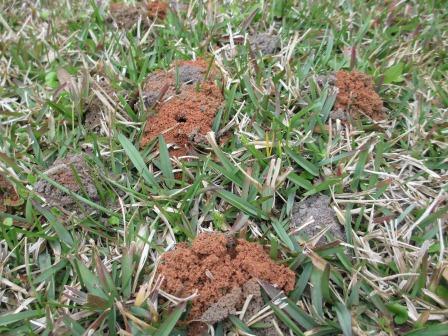Ground-dwelling bees get a lot of attention in late winter and spring as they create large numbers of small mounds in local lawns and landscapes.
Many people become concerned as they see these bees hovering close to the ground out in their lawns and landscapes. But these bees are interesting, docile, beneficial and are unlikely to sting.
These bees are known as andrenid bees or mining bees. Andrenid bees are solitary. As the name implies, they live alone. However, they may nest in close proximity to one another but they do not form a colony or hive. They produce individual mounds with a small entrance hole. The bees are approximately ½ inch in length with a black body.
 Richard Sprenkel, retired UF/IFAS Entomologist, explains their biology in today’s article.
Richard Sprenkel, retired UF/IFAS Entomologist, explains their biology in today’s article.
“After mating in late winter and early spring, the female selects a site that has dry, loose soil with sparse vegetation. She excavates a vertical shaft in the soil that is approximately the diameter of a pencil and up to eighteen inches deep. Off of the main shaft, the female will construct several brood chambers that she lines with a waterproof material. The female bee provisions each brood chamber with pollen and nectar on which she lays an egg. The pollen and nectar sustain the larva until fall when the overwintering adult is formed. Early the following spring, adult bees emerge from the ground to begin the cycle again. There is one generation per year.”
The small mound of soil that is excavated from each burrow brings additional attention to the activity of the bees. As males continue to hover in the area of the burrows looking for unmated females, the bees appear more menacing than they actually are. Andrenid bees have a tendency to concentrate their nests in a relatively small area. The openings to the underground burrows may be no more than three to four inches apart.
The threat of being stung by these bees is usually highly overrated. The males cannot sting and the females are docile and not likely to sting unless stepped on, handled or threatened. While entrances to the tunnels and excavated soil may appear disruptive to the lawn, they usually are not damaging. It may appear that the grass is thin because of the bees but it is more likely that the bees are in the area because the grass was already thin. Control is usually not necessary. Because the andrenid bees forage to gather pollen and nectar, they are actually beneficial. They serve as pollinators this time of the year.
**** Photo Credited to UF / IFAS Extension Jackson County courtesy of Josh Thompson****
- Evaluate and Renovate Landscape During Fall - October 30, 2025
- Summer is Too Hot for Lawn Herbicides - August 23, 2025
- Nuisance Gnats abound in Northwest Florida this spring - June 26, 2025
